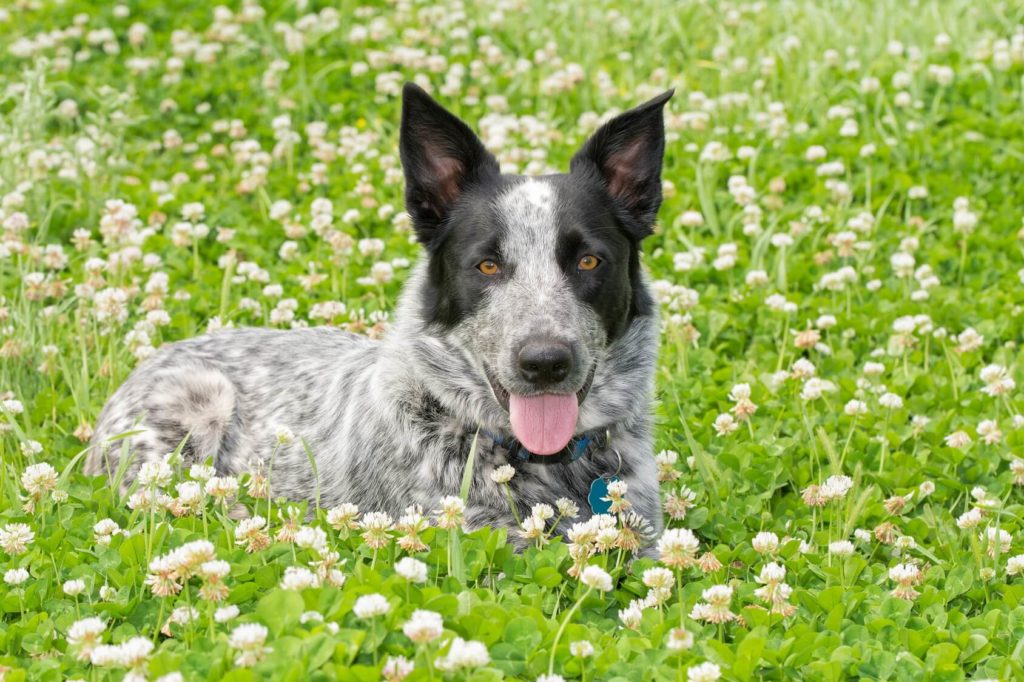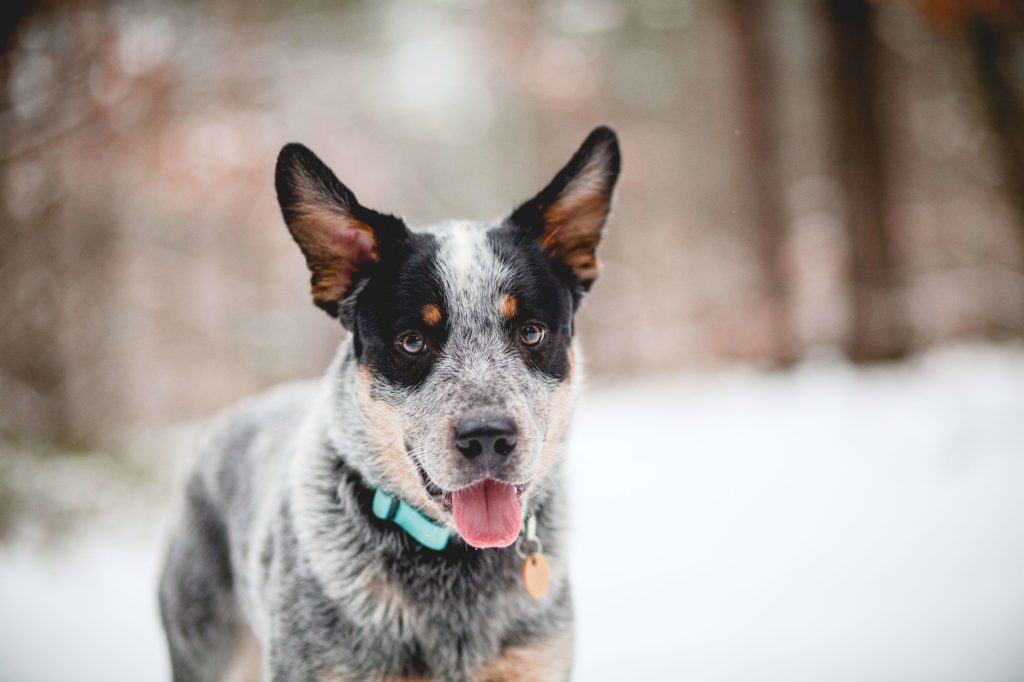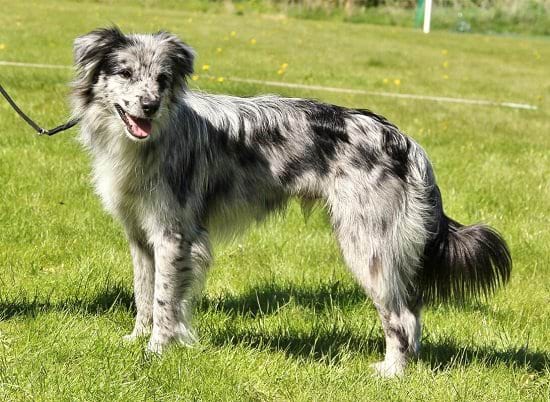The Blue Heeler Australian Shepherd Mix, also known as the Australian Cattle Dog Australian Shepherd Mix, is a unique hybrid breed that combines the herding abilities and intelligence of both the Australian Shepherd and the Blue Heeler (Australian Cattle Dog) breeds.
This crossbreed typically exhibits a strong work ethic, high energy levels, and a loyal, protective personality. Their distinctive appearance may feature a variety of coat colors and patterns, including black, blue, merle, and red.
Due to their strong herding instincts, this breed requires an active lifestyle and plenty of mental and physical stimulation. This breed make excellent companions for families and energetic individuals who have experience working with high-energy, intelligent dogs.
A Brief Overview of Blue Heeler Australian Shepherd Mix
| Other Names | Queensland Australian Shepherd Mix, Australian Shepherd and Cattle Dog Mix, Australian Shepherd Australian Cattle Dog Mix, Australian Blue Heeler Shepherd, Queensland Heeler Australian Shepherd Mix, Aussie Cattle Mix, Texas Heeler |
| Purity | Crossbred |
| Purpose | Herding |
| AKC Recognition | No |
| Size | Medium |
| Height | 17-22 inches |
| Weight | 25-50 pounds |
| Colors | Black, chocolate, grey, fawn, blue, red, bicolor, tricolor, merle |
| Child / canine friendliness | Moderate |
| Training difficulty | Low |
| Grooming upkeep | Easy |
| Exercise needs | Very High |
| Health | Good |
| Lifespan | 12-15 years |
| Puppy cost | $200-$700 |
What is a Blue Heeler Australian Shepherd Mix?

The Blue Heeler Australian Shepherd Mix, also known as the Texas Heeler, is a cross between the Australian Shepherd and the Blue Heeler.
Originating in Texas in the 1970s, this breed combines the exceptional herding abilities of both parent breeds. Recognized for their unmatched working skills, they’re a top pick for those seeking a dedicated herding dog. If you need a skilled and loyal herding partner, the Texas Heeler is an excellent choice.
Parent Breeds of Australian Shepherd Blue Heeler Mix
Origins and history of Australian Shepherd

The Australian Shepherd, originally bred in the United States, has a rich history rooted in sheep herding. Known for their intelligence and athleticism, they were once called “cowboy dogs” and were favored by Basque shepherds. Despite their name, they originate from California and have English Shepherd ancestry.
Today, Australian Shepherds excel in various roles like search and rescue, narcotics detection, and therapy due to their versatility and intelligence. Their loyalty and affection also make them great family pets. Whether you need a reliable working dog or a loving companion, the Australian Shepherd is a fantastic choice. Consider adding one to your family today!
Origins and history of Blue Heeler

The Blue Heeler, a renowned herding breed, originates from 19th century Australia. It was purposefully developed for cattle herding, known for its speed, strength, and independence.
Breeders created the Blue Heeler by crossing the Australian Dingo with collies and other herding breeds, aiming for a high-energy herder fit for the Australian climate. This resulted in a tenacious, hardworking, and independent breed that gained popularity among ranchers.
Today, Blue Heelers are still used as working dogs on farms and ranches while also making wonderful family pets due to their loyalty and affection. With their impressive abilities and intriguing history, the Blue Heeler is a cherished breed worldwide – a perfect choice for a loyal and hardworking companion!
What Does a Blue Heeler Australian Shepherd Mix Look Like?
The Blue Heeler Australian Shepherd Mix is a unique crossbreed, so there are no strict appearance standards. However, they typically have a medium-sized build with long, slender legs that suggest agility.
These mixes often inherit traits from both parent breeds, such as the erect ears and alert eyes of the Blue Heeler and even the distinctive smile of the Australian Shepherd. They have sturdy bodies with deep chests and strong forequarters and hindquarters, perfect for enduring long hours of work on the ranch.
Size, height, and weight
With a height ranging from 18 to 22 inches from paw to shoulder and a weight between 40 and 55 pounds, this mix can come in various sizes depending on which parent they take after more.
| Male | Female | |
| Size Group | Medium-large | Medium |
| Height | 18-22 inches | 17-19 inches |
| Weight | 30-50 pounds | 25-40 pounds |
Coat colors and types
The Australian Shepherd Blue Heeler Mix showcases a stunning variety of coat colors. They can appear in blue merle, calico, or a blend of different hues, often with black and grey spots inherited from their Blue Heeler lineage.
Their fur may be short or medium in length, yet it always feels silky and smooth. Surprisingly, despite their luxurious coat, they don’t shed excessively. A weekly brush is all it takes to keep their coat healthy and shiny.
Temperament and Personality

The Blue Heeler Australian Shepherd Mix is a highly energetic and hardworking dog with a strong herding instinct. They thrive on exercise and mental stimulation, and if not provided with an outlet for their energy, they can become destructive and aggressive.
This breed prefers spending time outdoors and needs space to stay active. They may seem distant when working, but they crave attention and affection once their energy is spent.
Expect frequent barking, especially around strangers, which can be managed with proper training. This mix is best suited for adult owners or households with older children and teens, as they may nip at younger children.
While they may not be overly cuddly, they express their love through helping and watching over the household.
Is Blue Heeler Australian Shepherd Mix a good fit for families?
Yes, these dynamic dogs, like their parents, the Blue Heeler and the Australian Shepherd, make terrific pets for individuals and families. However, they need ample space to run around and lose their energy.
Although they tolerate other canines, their herding instincts may entice them to nip at the heels of small children and other animals. This tendency may be eliminated by training them early.
Is Blue Heeler Australian Shepherd Mix aggressive?
No, the Blue Heeler Australian Shepherd Mix is not inherently aggressive.
They can be cautious around strangers and other dogs due to their herding instincts, but it doesn’t necessarily translate to aggression. With proper socialization and training, they can be excellent guard dogs without displaying aggression. However, their herding instincts may lead to nipping behavior, which, if left unchecked, can become a problem. Early training and guidance are essential to address this behavior and prevent it from escalating into aggression.
Training

Training an Aussie and Blue Heeler Mix can be challenging but rewarding, requiring dedication and patience. Starting your dog’s training program before they even come home is a wise move to nip any herding and barking tendencies in the bud. Here are some tips for training your puppy:
- Set boundaries and stick to them: These dogs are known to test their limits, so it’s essential to establish yourself as the pack leader.
- Repetition is key. Consistently reinforce commands until they become ingrained in your dog’s behavior.
- Stay positive during challenging training sessions: Your pup will pick up on your frustration, so keep the energy upbeat.
- Socialization is crucial, and it’s best done with your present: Your dog may be anxious around strangers, but early socialization can help them learn to get along with others.
- Give your dog daily challenges to exercise their endurance and brainpower: These dogs thrive on new experiences and mental stimulation, so take them on hikes, runs, and other adventures.
- Play games like the tag to engage your dog’s natural herding instincts safely and excitingly: Use the opportunity to practice commands like sit, stay, and heel while they’re having fun.
Exercise Requirements
Exercise is crucial for the Australian Cattle Dog and Australian Shepherd Mix. They need 1-2 hours of vigorous exercise daily, ideally split into two sessions of 30-60 minutes each. A simple walk won’t suffice due to their high energy.
To prevent boredom, engage them in activities like agility, flyball, or frisbee. Keep in mind that their exercise needs can be demanding, so be prepared to commit to their playtime if you’re considering this breed.
Living Conditions
The Aussie Blue Heeler Mix isn’t one for city living – they need wide open spaces to stretch their legs and explore! Small apartments and limited outdoor areas won’t do.
You’re asking for trouble if you try to keep this energetic breed cooped up too long. They’ll get bored and frustrated and may start acting out violently – chewing on things they shouldn’t, barking too much, or even nipping at people.
To keep your furry friend happy and well-behaved, ensure they have plenty of outdoor time and opportunities to exercise and explore.
Grooming and Cleaning
- Lucky for you, this breed has a short, silky coat that doesn’t shed too much. But wait to get comfortable! You’ll still need to brush them once a week to keep their skin healthy and shiny.
- Since these puppies love to play outside, you must check their ears regularly for any dirt buildup. Their adorable pointy ears get dirty quickly, so watch them.
- Running around all day also helps keep their nails short, but checking them every two to three weeks is still recommended. If you use nail clippers, get them used to it as a pup.
| Grooming need | Frequency |
| Hair brushing | 1-2 times a week. |
| Bathing | Every 6-8 weeks. |
| Ear cleaning | Weekly. |
| Tooth cleaning | 2-3 times a week. |
Are Blue Heeler Australian Shepherd Mix Hypoallergenic?
No, the Blue Heeler Australian Shepherd Mix is not hypoallergenic, so if you have dog allergies, this breed may not be the best choice.
Food and Diet
For a healthy diet, your puppy should have around 1200 daily calories from protein, carbohydrates, and healthy fats. Split this into three servings of high-protein kibble. You can swap one serving with cooked chicken or steak for a treat.
Choose dog food with real meat as the main ingredient, avoiding fillers or byproducts. Keep in mind that weight gain peaks between 3 and 6 months, with males reaching 30-50 pounds and females weighing 25-40 pounds before their second birthday.
Common Health Issues

Prepare for some doggone health concerns with the Blue Heeler Australian Shepherd Mix! Although generally healthy due to their working breed lineage, this dog still has a few potential issues you should watch out for.
1.Eye problems
The gorgeous peepers of the Blue Heeler Australian Shepherd Mix are susceptible to numerous issues like cataracts, progressive retinal atrophy, and Collie Eye Anomaly.
2.Hip dysplasia
The dreaded hip dysplasia is an inherited ailment that can induce excruciating agony and limpness in the hips and ultimately progress to arthritis.
3.Allergies
This breed are frequently sensitive to grains like wheat and corn. As a result, it’s critical to select a diet free of these allergens to prevent adverse reactions.
4.Epilepsy
Epilepsy is a neurological disorder that can affect dogs of any age and lead to sudden, unpredictable seizures. Unfortunately, there is no known cure for this affliction, but medication can be given to help manage and minimize the severity of attacks.
5.Cancer
The frightening reality is that cancer can strike any breed, and the Blue Heeler Australian Shepherd Mix is no exception. Early detection and swift treatment are critical to a favorable prognosis for the affected dog.
6.Deafness
Deafness can concern, especially for those with merle coloring. This may occur from birth or develop later in life. But fear not, as deaf dogs have been known to adapt to their environment using their other senses to compensate. While it can pose challenges, it’s a manageable condition. However, it’s important to note that deafness is not as prevalent in non-merle-colored dogs.
How Much Is a Blue Heeler Australian Shepherd Mix?
The Blue Heeler Australian Shepherd Mix will cost you a pretty penny, ranging from $200 to $700. The Blue Heeler Aussie Mix price varies depending on a variety of factors, such as the age and location of the breeder.
| Age | Price |
| Puppy | $200-$700 |
| Adult | $200-$400 |
| Adoption | $150-$250 |
How Long Does a Blue Heeler Australian Shepherd Mix LIve?
The lifespan of the Blue Heeler Australian Shepherd Mix is quite impressive, ranging from 13 to 16 years.
Is a Blue Heeler Australian Shepherd Mix The Right Dog For Me?
The Blue Heeler Australian Shepherd Mix is an excellent pick for an energetic and brainy furry buddy who will keep you engaged. But, if you’re a newbie at pet parenting, think twice. For many, the Blue Heeler Aussie Mix’s living space needs can be excessive.
However, if you’re up for the adventure, they can be fantastic pals. Whether you live solo or have a family with kids, this pup will fit in perfectly and soon become a beloved part of your family.
List of dogs that are similar to Blue Heeler Australian Shepherd
- Australian Shepherd-Catahoula Mix
- Blue Merle Australian Shepherd
- Australian Shepherd-Rottweiler Mix
- Blue Merle Aussiedoodle
- Blue Heeler-Rottweiler Mix
- Blue Heeler-Husky Mix
- Blue Heeler-Catahoula Mix
Frequently Asked Questions
1.Do Blue Heeler Australian Shepherd Mixes Shed A Lot?
Yes, they do. The Blue Heeler Australian Shepherd Mix sheds moderately throughout the year. Regular brushing can help reduce the amount of hair in your home.
2.Are Blue Heeler Australian Shepherd Mixes good dogs?
Yes! These pooches are a complete package of loyalty, intelligence, hard work, and protectiveness. They make excellent family dogs; however, their innate herding instincts might cause them to nip at the heels of small pets and children.
But fear not. If you want an Aussie Heeler Mix but have small children, it’s essential to start training your pup early. Behavioral and socialization training ensures your furry friend is well-behaved around children and other pets.
Conclusion
In conclusion, the Blue Heeler Australian Shepherd Mix is a fascinating and highly capable hybrid breed that blends the intelligence and work ethic of both the Australian Shepherd and Blue Heeler breeds.
These dogs are highly active and require plenty of mental and physical stimulation to stay healthy and happy. They make excellent companions for experienced dog owners who enjoy an active lifestyle and have the time and dedication to meet their needs.
Due to their strong herding instincts, early socialization and training are essential to ensure they develop into well-behaved and obedient pets. If provided with proper care, love, and attention, the Blue Heeler Australian Shepherd Mix can become a loyal and affectionate companion for many years.
